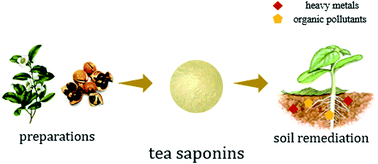Tea saponins: effective natural surfactants beneficial for soil remediation, from preparation to application
Abstract
Tea saponins, found in Camellia plants, are natural non-ionic surfactants that offer obvious beneficial effects in soil remediation. Most tea saponins are extracted from the Camellia oleifera seed meal, with the leaves and flowers of Camellia sinensis as potential sources. Water extraction and ultrasound-assisted water extraction combined with acetone precipitation are recommended for the industrial extraction and purification of tea saponins, considering multiple factors. The detailed physical, chemical and biochemical properties of tea saponins need to be clarified, especially whether tea saponins with slightly different structures from distinct sources have different soil remediation properties. Applied in leaching remediation, phytoremediation and microbial remediation, tea saponins desorb heavy metals from contaminated soil as well as enhancing their bioavailability. Tea saponins improve the accumulation of pollutants by hyperaccumulators as well as the degradation of organic pollutants by microorganisms. Currently the mechanisms of tea saponins are not clear, although they are proven to be effective natural surfactants for the remediation of contaminated soils. This review enriches our understanding of tea saponins from various aspects and encourages further studies of industrial extraction and purification, and the field remediation mechanisms of tea saponins, making better use of Camellia plants and contributing to environmental protection.



 Please wait while we load your content...
Please wait while we load your content...